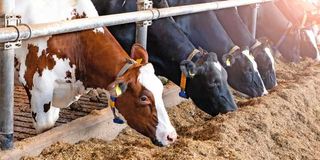Premium
Pay close attention to the appetite of your dairy cows

All animal breeds will have long, curly and thin hair when there is inadequate protein in the diet.
I have said many times on this forum that a dairy cow is its breed or genetic make-up, what it eats or feeding and nutrition, and management or how the animal is taken care of by its owner. Often, I find dairy farmers concentrating too much on the genetics of the animals and ignoring everything else.
Where a farmer only prioritises genetics, the results are almost always disappointing. A few months back, a farmer called me to his office in Nairobi to discuss dairy cattle he wanted to import from Saudi Arabia. The farmer had visited a prominent farm in the country and was impressed by the high level of milk production by the Friesian cows. They produced over 60 litres of milk per cow daily. The farmer told me he wanted to import the animals to Kenya, breed them and supply replacement stock to other farmers in his area in the Rift Valley.
I asked him about his current stock and what the production was like. He had about 50 Friesians that produced on average 12 litres of milk per cow daily. He shared photos of some of his cattle.
From the information the farmer provided and the photos of the cows, it was obvious to me he had very good animals genetically. They could give him over 30 litres of milk per cow daily if they were well-fed and managed. I explained to the farmer that even if he imported the animals he had seen abroad, fed them and managed them the way he was doing his current stock, he would end up with the same production he was currently getting. The farmer vehemently disagreed but I gave him a proposal. Instead of spending lots of money importing the top producers, he could obtain cattle locally, producing 45-50 litres of milk per cow daily. He would then treat the new cows in exactly the same way he was doing his current stock. He would achieve the same low level of production on his farm. The problem was not genetics. It was nutrition and management.
Poor body condition
Apart from low production and poor body condition, nutrition also affects the coat colour of animals. Friesians and other black animals normally have reddish coats when they lack sufficient copper in the diet. Red animals become yellowish. All animal breeds will have long, curly and thin hair when they have inadequate protein in the diet.
You see, nutrition is about the animal’s diet having the various components of nutrients in the correct quantity. Feeding, however, is about giving the right quantities of feed to each animal. The nutrition components of feeds are carbohydrates, proteins, vitamins, minerals and water.
Dairy farmers many times find it difficult to understand why animal health and production service providers almost always diagnose poor feeding and nutrition in herds. Last week I visited a farmer in Kiambu who, at some point, had told me he thought I was over-diagnosing poor nutrition and feeding on his farm. The animals had good appetite, discoloured hair coats, low energy and poor production. My diagnosis was that the animals were getting right quantities of feed but the feed quality was poor. I advised the farm to plant Super Napier and mix it with corn to improve on the feed quality.
My visit last week confirmed the farmer had fully implemented my advice. The cows’ hair coats were shiny, short and crisp. This time, the farmer was happy my diagnosis was good feeding and nutrition.
The main purpose of my visit to the Kiambu farm last week was to give a second opinion on a cow that had calved recently, had gone down and was treated for milk fever but was still unable to stand. I was told the cow had showed reluctance to eat dairy meal before it went down. It had also looked weak, though it was in good body condition. The animal had calved easily and dropped the placenta within 12 hours.
I examined the animal and found all vital parameters to be normal. The rumen had strong movements and the animal eagerly ate dry grass when I presented a handful. The nose was wet and eyes fairly bright. I ruled out milk fever. The cow was still reluctant to eat dairy meal and had a whiff of “hangover breath”. This is breath like one detects in a drunkard a day after heavy drinking.
Low supply of carbohydrates
I diagnosed a condition called ketosis. This is a disease that affects some dairy cattle after calving. It is caused by low supply of carbohydrates to the animal in the diet. The animal is then forced to breakdown its body fat resources to generate energy.
Heavy fat breakdown produces harmful chemicals called ketones that are detected in the animal’s breath. The ketones weaken the body muscles and cause the animal to go down and be unable to stand. If ketosis is not diagnosed early and treated, it may result in the death of the animal or permanent damage to muscles.
I instructed the cow be given a product called Ketonex that mainly contains propylene glycol. It is a highly effective treatment for ketosis.
The cow quickly uses the propylene glycol to produce glucose, which is the normal body fuel. The product should be given daily for five to 10 days until the animal stands again.
Dairy farmers should always keep propylene glycol on their farms to treat animals that show the early signs of ketosis such as muscle weakness and low appetite for dairy meal or grains. Such animals should be given dry grass and the propylene glycol until their appetite for concentrate feed returns.





